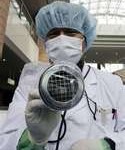The government’s Nuclear and Industrial Safety Agency upgraded its provisional evaluation based on an estimate that radioactive materials far exceeding the criteria for level 7 have so far been released into the external environment, but added that the release from the Fukushima nuclear plant is about 10 percent of that from the former Soviet nuclear plant, Kyodo reported.
Japan raised the severity level of the ongoing emergency at the crippled Fukushima Daiichi nuclear power plant from level 5 to the maximum 7 on an international scale, recognizing that the tsunami-caused accident matches the world’s worst nuclear catastrophe in 1986 at Chernobyl.
Level 7 accidents on the International Nuclear Event Scale correspond to the release into the external environment of radioactive materials equal to more than tens of thousands of terabecquerels of radioactive iodine 131. One terabecquerel equals 1 trillion becquerels.
The nuclear regulatory agency under the Economy, Trade and Industry Ministry and the Nuclear Safety Commission of Japan, a government panel, said that between 370,000 and 630,000 terabecquerels of radioactive materials have been emitted into the air from the Nos. 1 to 3 reactors of the plant.
Chief Cabinet Secretary Yukio Edano emphasized that the raising of the severity level does not mean the situation at the Fukushima plant is ”worsening.”
The top government spokesman said the latest assessment is simply based on data which are more accurate than the time it made its previous assessments.
